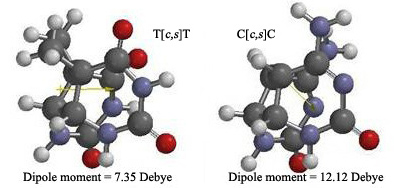Wednesday, 16 May 2007
3rd Floor Hall (Pfahler Hall)
66
The Effect of the Electric Dipole Moment of Cis,Syn Cyclobutane Cytidine Dimer on the Active Site Flavin of DNA Photolyase
Cyclobutane pyrimidine dimers (CPD) are formed in DNA as the result of UVA, UVB and UVC irradiation and are responsible for transcription and replication errors leading to skin cancer. Thymine dimers have an immediate effect on these processes, while cytosine dimers result in C→T and CC→TT mutations via deamination of CPD cytosine to CPD uracil. DNA photolyase, or phototoreactivating enzyme, is the most efficient CPD repairing enzyme, which repairs both T[c,s]T and C[c,s]C. The electric dipole moment of the cyclobutane dimer perturbs the electronic structure of the flavin cofactor in DNA photolyase, which enables monitoring properties of enzyme � substrate complexes using different spectroscopic techniques. Using ab initio calculations and methodologies of biophysical chemistry we have predicted and observed significant differences between the properties of the electric dipole moments of thymine and cytosine dimers and their effects on charge recombination and on the S0→S1 electronic transition of the flavin cofactor in DNA photolyase.
Back to Poster Session I
Back to The Middle Atlantic Regional Meeting (May 16 - 18, 2007)
